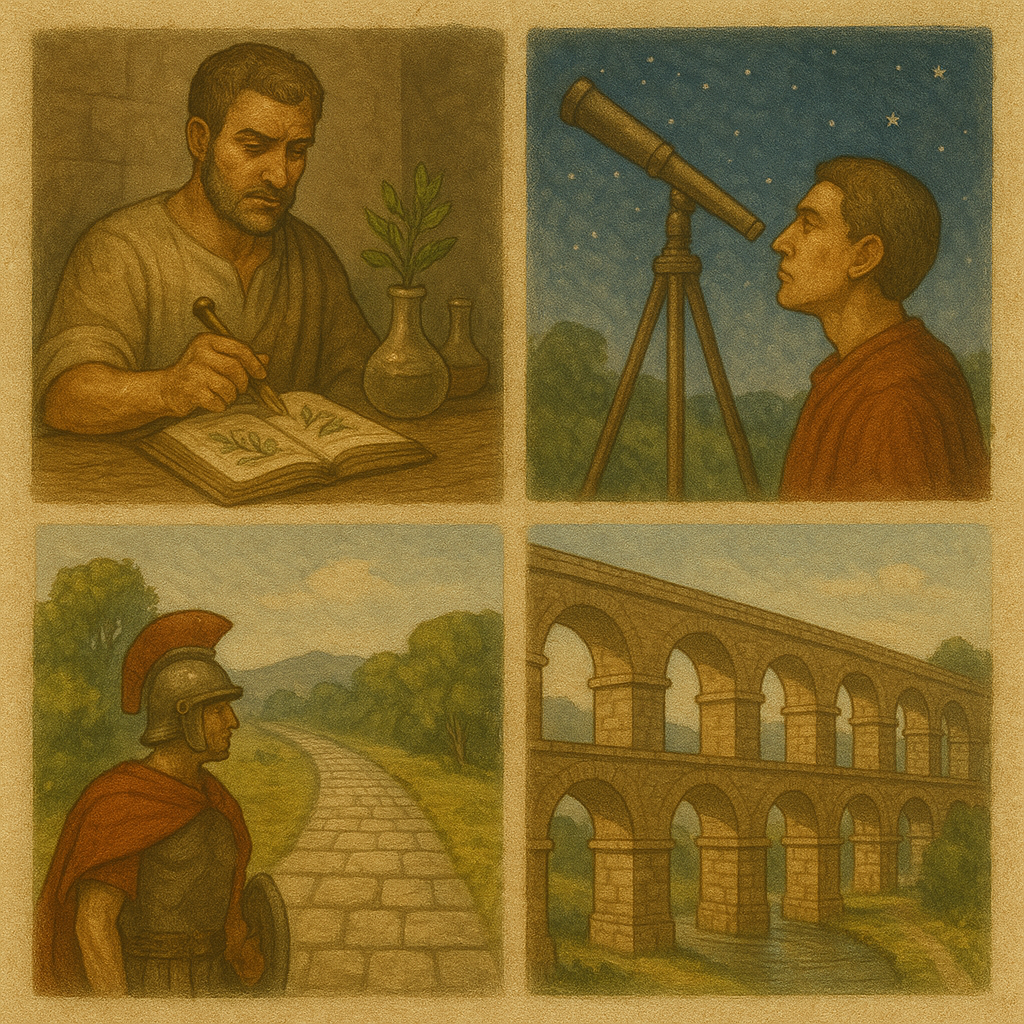Lesson 6: Rome’s Legacy (Ancient Rome)
Roman Science and Engineering 🔬🛠️
Romans were not just good fighters — they were great builders and thinkers too! Roman scientists studied plants, animals, and the stars. Roman engineers built strong roads, aqueducts (special bridges for water), and amazing buildings.
Roads: Roman roads were so well made that some are still used today! Soldiers could travel fast across the empire thanks to these roads.
Aqueducts: Romans needed a way to bring fresh water into their cities. They built long aqueducts that carried water from far away, using only gravity!
Interesting Story:
One famous Roman engineer was Vitruvius. He wrote a big book about how to build strong and beautiful buildings. Later, many artists, like Leonardo da Vinci, used Vitruvius’s ideas to make their art even better! 📚
Architecture and Art 🏛️🎨
Roman buildings were strong and beautiful. They used arches, domes, and columns in their architecture. Roman art showed real people and real life, not just perfect gods like in Greek art.
Colosseum: A giant arena in Rome where people watched gladiator fights. It could hold over 50,000 people!
Roman Statues: Romans made very realistic statues showing wrinkles, scars, and emotions.
Interesting Story:
Roman builders were so good at making concrete that their buildings lasted for thousands of years. In fact, Roman concrete is even stronger than most modern concrete! Scientists today are still studying it to understand the secret. 🧪
One amazing building made with Roman concrete is the Colosseum. It survived earthquakes, fires, and even World War II bombings! The Romans used volcanic ash in their concrete, which helped it heal tiny cracks over time. That’s why so much of Roman architecture is still standing after almost 2,000 years! 🏟️
Literature and Language 📖🗣️
The Romans loved writing stories, poems, and speeches. Latin, the language they spoke, became the "mother" of many languages today, like Spanish, French, and Italian!
Famous writers:
Virgil wrote the Aeneid, a story about a brave hero who helped start Rome.
Ovid wrote fun love poems and stories about the gods.
Cicero was a famous speaker who taught people how to argue well.
Interesting Story:
The Aeneid by Virgil tells how a hero named Aeneas escaped the burning city of Troy and traveled a long way to find a new home — which would one day become Rome! Romans loved this story because it made their city seem chosen by the gods. ✨
The Beginning of Civil Law ⚖️📜
Romans were also good at making laws. They wanted rules that were fair for everyone. They wrote down their laws so that all citizens would know them. This was very important — no king could just make up new rules whenever he wanted!
Twelve Tables: In 450 BC, Rome wrote its first laws on bronze tablets and put them in the public square so everyone could see them.
Roman law later became the base for many modern laws around the world!
Interesting Story:
If two people argued over land or money, they could go to a Roman court. Judges would listen and decide who was right based on the laws, not on who was richer or more powerful. This idea — that the law is above everyone — is still important today! 🏛️
Philosophy and History 🧠📚
Romans loved Greek philosophy (thinking about life and right and wrong). Many Romans studied ideas about being brave, calm, and wise.
Stoicism: A Roman favorite. Stoics believed you should control your emotions and do your duty, even when life is hard.
Famous thinkers:
Seneca taught that happiness comes from living simply and wisely.
Marcus Aurelius, a Roman emperor, wrote a book called Meditations about how to live a good life.
Romans also loved writing history to remember the good (and bad) things their leaders did.
Interesting Story:
Marcus Aurelius was both a great emperor and a philosopher. When he was tired from battles and ruling a giant empire, he wrote down his thoughts at night to remind himself to stay calm and good. His personal notes became the book Meditations — and people still read it today to find wisdom! 🌟
Rome’s Legacy is everywhere today — in our buildings, our languages, our laws, and even the way we think about life!
